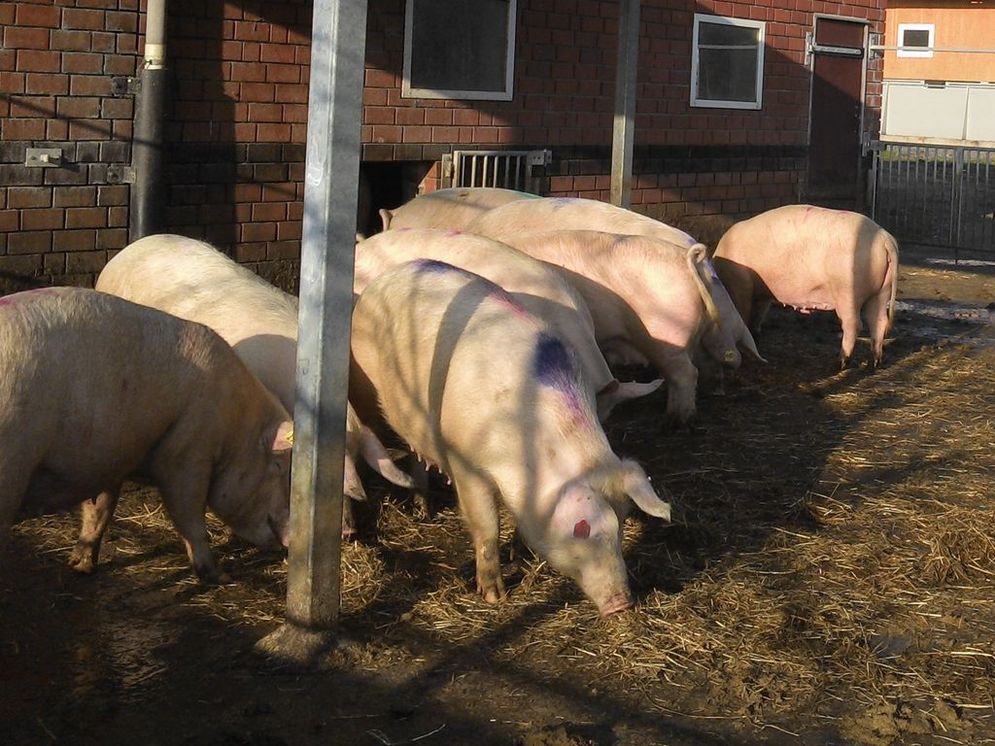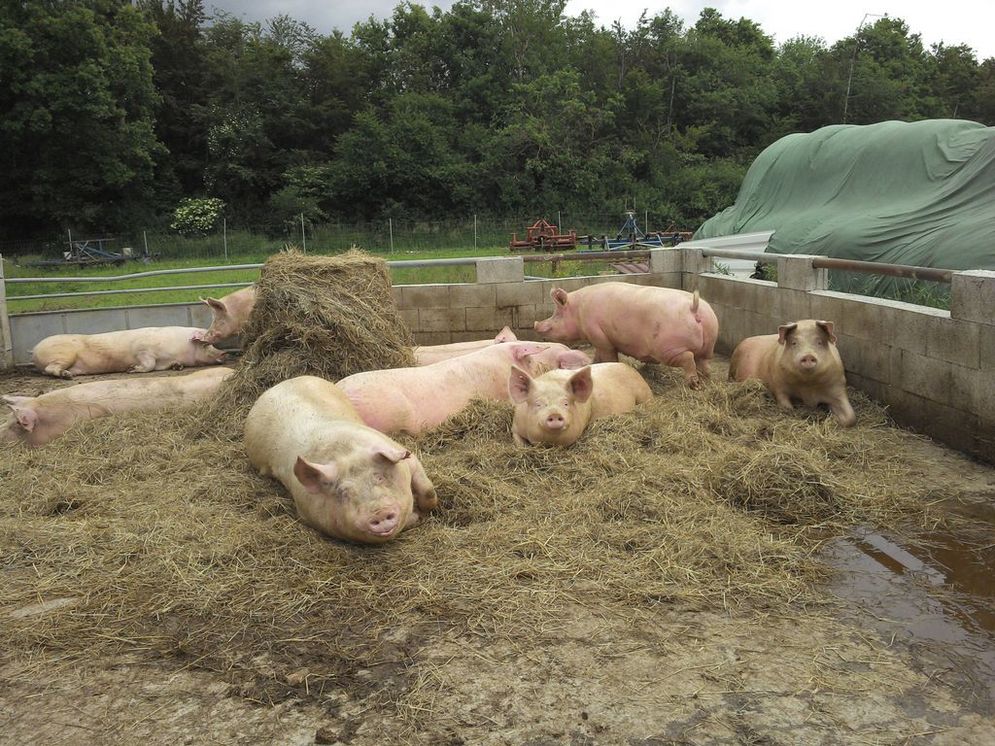Project
Clumsy Pigs: do organic sows also suffer from clinical lameness and joint injuries?

Prevalence and risk factors for lameness in organic sows kept in housing systems with outdoor runs
Sows in conventional husbandry often suffer from diseases in their locomotor systems, leg injuries and lameness. What is the situation on organic farms where pigs have outdoor runs? What risk factors have the most influence here?
Background and Objective
Practical experience shows that lameness often causes losses and thus a financial loss for the farm. If, on the other hand, sows have a good foundation, this results in long usages periods and high productivity. In addition lameness seriously disadvantages the welfare of the animal: Some studies show that lameness occurs much less frequently in organic pig keeping as in conventional pig keeping. Until now only few studies addressed this topic, in particular with regard to organic agriculture in Germany
The EU organic regulations require group husbandry for sows, also required are outdoor runs and a littered (mostly with straw) lying area. To assess whether these requirements prevent lameness organic sow husbandry, we studied in 40 organic farms throughout Germany. We concentrated on breeding sows, since sows are kept for a longer time in the husbandry system as fattening pigs. We also wanted to find out which risk factors can be held responsible for the occurrence of lameness s in husbandry practices with outdoor runs.
Target Group
Agricultural practitioners, consultants and associations
Approach
We visited 40 organic farms with sow keeping throughout Germany and could provide ifnoramtion with this field study.
Potential risk factrs from the housing environment and management were evaluate on the basis of current literature in and survey protocols.
In addition to performance parameters, management measures, and the situation in the stable we were able to identify a number of parameters directly from the animals, for example by evaluations of their gait, changes on their appendages, and also injuries, the body condition and degree of dirtiness.
The occurrence of lameness in organic husbandry systems with outdoor runs shall be described on the basis of our survey and, in addition, the most important causes thereof.
Data and Methods
We chose suitable evaluation schemes from earlier projects to document animal-related parameters in this field survey and checked them with regard to their reliability and applicability in on-farm assessment. Before we started our farm surveys, we trained the project staff in the application of the evaluation schemes and carried out observational alignments. This means that project staff evaluated animals separately and had to attain a good accordance in their evaluations so that the comparability of the results of the animal assessments could be assured.
We analysed the risk factors for the occurrence of lameness with multivariate statistics.
Expected of Preliminary Results:
Since the project has not yet concluded, no final results are available.
However, it can already be seen that less clinical lameness in sows occurs in organic farming as in conventional pig keeping.
The mean lameness prevalence in all studied farms observing the husbandry requirements of the EU Regulations for Organic Farming (among other things the availability for outdoor runs and litter in the lying area, was at a much lower level than described in the literature for conventional sow husbandry. This seems to be due to differences in the husbandry environments of the various production systems.
Results
The aim of this study was to assess lameness prevalence in organic sows as well as to identify factors associated with lameness. The project focused on sows kept indoors with access to an outdoor run. Sows were chosen since they are kept for a longer period of time as compared with fattening pigs and therefore influencing factors from the housing environment may have a greater impact on them. Furthermore, leg health is a prerequisite for animal welfare, productivity and longevity.
40 farms in Germany were visited once and lameness as well as leg health was assessed on an individual level. Mean prevalence of lameness in pregnant sows was 6,9 % (0 – 34,8 %, Median 5,1 %) and thus substantially lower than data from conventional pig farming.
Risk factor analyses using multivariate logistic regression revealed the following influencing factors: In farms, for which the litter number of individual sows was known (n=28 farms, 447 sows), the risk for lameness increased with increasing litter number and with the number of swellings on the legs. Analysis of the total dat set (n=40 farms, 1,111 sows), but not considering the litter number, the factors claw length (higher risk with too long claws), self-assessment of lameness by the farmers (higher risk when deviating from the true prevalence), provision of access to an outdoor run for gilts (less lameness, when outdoor run available) and cleaning of the pens for pregnant sows (higher risk when cleaning takes place regularly) remained in the final model.
In conclusion, the regulations concerning organic sow husbandry provide conditions, which are well suited to allow for reasonable levels of lameness. Nevertheless, there is a clear importance to strengthen the management abilities of farmers to be aware of health & welfare problems and to improve housing conditions and management measures regarding the farm specific problems considering animal based parameters.
Links and Downloads
Duration
1.2012 - 12.2014
Thünen-Contact

Involved Thünen-Partners
Involved external Thünen-Partners
- Friedrich-Loeffler-Institut, Bundesforschungsinstitut für Tiergesundheit (FLI)
(Greifswald-Insel Riems, Braunschweig, Celle, Deutschland) - Universität für Bodenkultur (BOKU)
(Wien, Österreich)
Funding Body
-
Federal Ministry of Food und Agriculture (BMEL)
(national, öffentlich)
Duration
1.2012 - 12.2014
More Information
Project funding number: 11OE098
Funding program: Bundesprogramm Ökologischer Landbau und andere Formen nachhaltiger Landwirtschaft (BÖLN)
Project status:
finished
Publications
- 0
March S, Brinkmann J, Schwalm A, Leeb C, Dippel S, Weißmann F, Winckler C (2015) Erste Ergebnisse einer Untersuchung zu Lahmheiten bei ökologisch gehaltenen Zuchtsauen in Stallhaltung mit Auslauf. In: Häring AM, Hörning B, Hoffmann-Bahnsen R, Luley H (eds) Beiträge zur 13. Wissenschaftstagung Ökologischer Landbau "Am Mut hängt der Erfolg: Rückblicke und Ausblicke auf die ökologische Landbewirtschaftung". pp 474-477

![[Translate to English:] [Translate to English:]](/media/_processed_/8/e/csm_Bildschirmfoto_2021-03-03_bearb_fc48ac88bf.jpeg)
![[Translate to English:] [Translate to English:]](/media/_processed_/8/e/csm_Bildschirmfoto_2021-03-03_bearb_ba3ec0e9d7.jpeg)


![[Translate to English:] Logo des Bundesministerium für Ernährung und Landwirtschaft](/media/allgemein/logos/BMEL_Logo.svg)